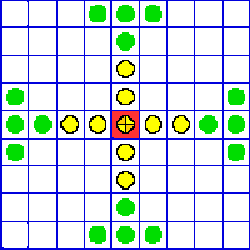
TABLUT
compiled by Modar Neznanich
Tablut is a Finnish tafl game.
A tafl game is one where the sides are unequal (in size or strength).
This is a variation of the Norse game known as Hnefatafl.

In Tablut the two sides are known as the Attacker Side and the Defender Side (sometimes called the King Side).
It is played on a 9 square by 9 square board.
Playing pieces move orthogonally. (Vertically or horizontally, but not diagonally.)
The Attacker Side starts with 16 playing pieces (positioned in the above diagram as green pieces).
The Defender Side starts with 9 playing pieces (positioned in the above diagram as yellow pieces). There are 8 regular pieces and 1 King piece. (The King piece is marked in the above diagram with a "+" symbol on it.
The center square of the board, called the King's Square is depicted as red in the above diagram.
The object of the Attacker Side is to capture the King, which is accomplished by surrounding the King on all four orthogonal sides, or surrounding the King on three sides with the center square of the board (the King's Square) being the fourth side, or if the King and another Defender piece are enclosed on all sides so that neither the King or the other Defender piece can move.
The object of the Defender Side is to move the King piece off the board.
Other playing pieces (of either side) can be captured by orthogonal interception. That is to say that the piece is "caught" between two opposing pieces, either two horizontally, two vertically, or one of each.
If a playing piece moves between two opposing pieces voluntarily, it is NOT captured.
If the move of a Defender piece (either regular playing piece or the King piece) gives the King piece a clear line of exit from the board, the Defender player must announce this.
If the King piece has two clear lines of escape from the board, the Defender must announce this also.
If a move of an Attacker piece gives the King piece a clear line of exit from the board, no announcement must be made (by either side).
The players take turns moving one piece, beginning with the Attacker Side.
The number of squares a piece may be moved is determined by the roll of one 6-sided die.
The number roll on the die is the maximum number of spaces a piece may move; fewer spaces may be moved if desired.
The number may NOT be split between pieces. Only one piece is moved per turn.
A piece can only move in one direction during a turn.
©1998, 1999, 2000, 2001,
2002, 2003, 2004, 2005, 2006 Ron Knight
Baron Modar
Neznanich, OPel
Permission
to Print.
e-mail: modar@everestkc.net